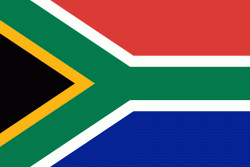Jan Kempdorp (Jan Kempdorp)
Jan Kempdorp is an agricultural town situated in the centre of the Vaalharts Irrigation Scheme in the Northern Cape province of South Africa. It is situated 96 km north of Kimberley, the provincial capital, and 43 km west of Christiana in North West province.
Jan Kempdorp was laid out on the farm Andalusia and at first bore that name. During the Second World War it was the site of a concentration camp housing German men regarded as potentially dangerous by the authorities. The first settlers bought plots in 1938, and the town was proclaimed in 1953 and named after General Jan Kemp, a former Minister of Lands. Municipal status was attained in 1967. Originally, the border between the Cape and Transvaal provinces ran through the town, making it the only town in South Africa that was in two provinces. This also led to confusion about the administration until in 1964 it was decided by Parliament that the town would be deemed to fall in the Cape for legal purposes.
When new provincial boundaries were drawn in 1994, Jan Kempdorp was still divided, now between the Northern Cape and North West provinces. The whole of the town was, however, included in the cross-border Phokwane Local Municipality. In 2006 cross-border municipalities were eliminated and the whole of the town was included in the Northern Cape.
During South Africa's Border War Jan Kempdorp was the location of a munitions store, guarded 24 hours a day by National Servicemen who were first required to be of a lowered medical classification.
Jan Kempdorp was laid out on the farm Andalusia and at first bore that name. During the Second World War it was the site of a concentration camp housing German men regarded as potentially dangerous by the authorities. The first settlers bought plots in 1938, and the town was proclaimed in 1953 and named after General Jan Kemp, a former Minister of Lands. Municipal status was attained in 1967. Originally, the border between the Cape and Transvaal provinces ran through the town, making it the only town in South Africa that was in two provinces. This also led to confusion about the administration until in 1964 it was decided by Parliament that the town would be deemed to fall in the Cape for legal purposes.
When new provincial boundaries were drawn in 1994, Jan Kempdorp was still divided, now between the Northern Cape and North West provinces. The whole of the town was, however, included in the cross-border Phokwane Local Municipality. In 2006 cross-border municipalities were eliminated and the whole of the town was included in the Northern Cape.
During South Africa's Border War Jan Kempdorp was the location of a munitions store, guarded 24 hours a day by National Servicemen who were first required to be of a lowered medical classification.
Map - Jan Kempdorp (Jan Kempdorp)
Map
Country - South_Africa
 |
 |
| Flag of South Africa | |
About 80% of the population are Black South Africans. The remaining population consists of Africa's largest communities of European (White South Africans), Asian (Indian South Africans and Chinese South Africans), and multiracial (Coloured South Africans) ancestry. South Africa is a multiethnic society encompassing a wide variety of cultures, languages, and religions. Its pluralistic makeup is reflected in the constitution's recognition of 11 official languages, the fourth-highest number in the world. According to the 2011 census, the two most spoken first languages are Zulu (22.7%) and Xhosa (16.0%). The two next ones are of European origin: Afrikaans (13.5%) developed from Dutch and serves as the first language of most Coloured and White South Africans; English (9.6%) reflects the legacy of British colonialism and is commonly used in public and commercial life.
Currency / Language
| ISO | Currency | Symbol | Significant figures |
|---|---|---|---|
| ZAR | South African rand | Rs | 2 |
| ISO | Language |
|---|---|
| AF | Afrikaans language |
| EN | English language |
| ST | Sotho language |
| SS | Swati language |
| TS | Tsonga language |
| TN | Tswana language |
| VE | Venda language |
| XH | Xhosa language |
| ZU | Zulu language |















